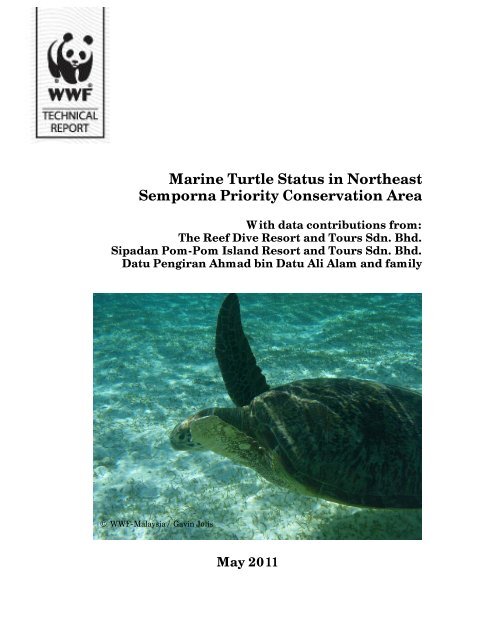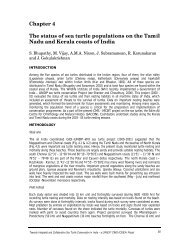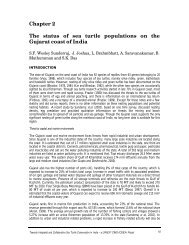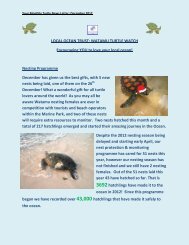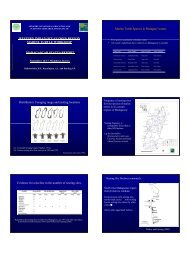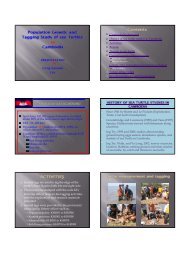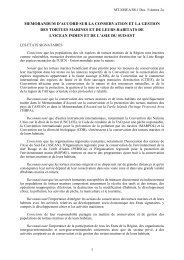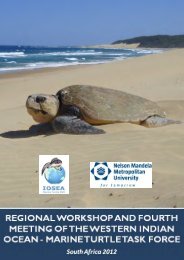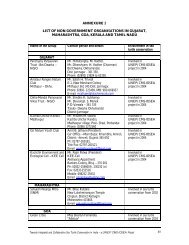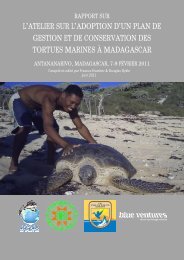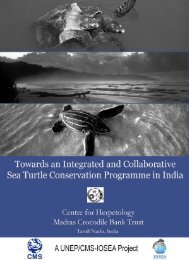Marine Turtle status Report - Indian Ocean - South-East Asian ...
Marine Turtle status Report - Indian Ocean - South-East Asian ...
Marine Turtle status Report - Indian Ocean - South-East Asian ...
Create successful ePaper yourself
Turn your PDF publications into a flip-book with our unique Google optimized e-Paper software.
AcknowledgementsWe wish to thank supporters of WWF-Malaysia Semporna PCA project: WWF-Netherlands, the Hupkes Family and the Adessium Foundation in theNetherlands. Our gratitude to resort operators, island villagers, staff andvolunteers who have assisted in the assessment (The Reef Dive Resort and ToursSdn. Bhd. of Mataking Island: Luke Cox, Masuara Majawi, Amelia Ng, and thepatrollers; Sipadan Pom-Pom Island Resort and Tours Sdn. Bhd. of Pom-PomIsland: Peter Loong, Sally Usher, Carla Modugna, Michelle Trigg, RaynerIgnatius, and the patrollers; Pulau Sipadan Resort and Tours Sdn. Bhd.: KenChung, Arthur Severinus and staff based on Timba-Timba Island; Datu PengiranAhmad bin Datu Ali Alam and family of Pandanan Island; Ibnu bin Amil and thecommunity of Kulapuan Island; Abdul Muhi Marabahan, Roni bin Gustami andthe community of Boheyan Island; PGA personnel in Kulapuan, Pom-Pom andMataking Islands; Army personnel in Pandanan and Boheyan Islands; Norlianabinti Mabustan, Fredyanna Gabriellia Tinsung, Nattelee Lim Shu Lee, Nina Hoand Mohammad Harris bin Bakarah). Special thanks to Sally, Amelia and DatuPengiran Ahmad for sharing their nesting data. Thanks to Angela Lim, SeniorCommunications Officer, SSME Programme, WWF-Malaysia for patiently editingthis report; and Sikula Magupin, GIS Officer, WWF-Malaysia, for producing themaps in this report.vi
Executive SummaryLying at the extreme southeast corner of Sabah, the Semporna District waterscontain parts of the globally significant Semporna Priority Conservation Area(PCA) of the Sulu-Sulawesi <strong>Marine</strong> Ecoregion (SSME). The area is known for itsextremely high coral and fish richness, productive marine habitats, intactecosystem of Sipadan Island Park and frequently used migratory pathway ofmany charismatic species including marine turtles. Despite their abundance, the<strong>status</strong> of marine turtles in Semporna is largely unknown and is limited to severalstudies on populations and human-turtle interactions. Hence, betweenNovember 2009 and April 2010, an assessment was carried out by WWF-Malaysia with island communities and resort operators to address the gaps ininformation. WWF-Malaysia surveyed six islands located in the northeast of theSemporna PCA. The number of species, distribution, nesting abundance, nestingseason, and threats of marine turtles in the area were qualitatively investigatedthrough stakeholder interviews and rapid surveys.The three species of marine turtles found in the northeast Semporna PCA areGreen turtle (Chelonia mydas), Hawksbill turtle (Eretmochelys imbricata) andthe occasional Olive Ridley turtle (Lepidochelys olivacea). The six islandssurveyed were Mataking, Pom-Pom, Pandanan, Timba-Timba, Kulapuan, andBoheyan. With proactive thinking and commitment to turtle conservation, tworesort operators and a local family were observed to manage turtle hatcheries inthe area. They patrol the beaches along the islands of Mataking, Pom-Pom andPandanan for nests. Once found, eggs are transported to hatcheries as soon aspossible. Each nest is then labeled and recorded.Identified threats include poaching of eggs from nests for food or sale; hunting ofadults for food; natural predators (monitor lizards, ghost crabs and ants) anddomesticated predators (cats and dogs) that prey on eggs and hatchlings; coastaldevelopment; erosion of nesting beaches; incidental capture; discarded plasticbags; boat propeller accidents; fish bombing; human-wildlife conflict at seaweedfarms; and cutting of coastal vegetation.The results of this assessment will be used as a baseline for monitoring as well asconservation planning and management of marine turtles in the Semporna PCA.Recommendations and next steps suggested include habitat protection, nestprotection (eggs and hatchlings), education and awareness, and long-termmonitoring programme, as well as collaborative and responsible eco-tourism.vii
Ringkasan EksekutifPerairan Daerah Semporna yang terletak di bahagian Tenggara Sabah,merupakan sebahagian daripada Kawasan Pemuliharaan Keutamaan Sempornadi Ekorantau Marin Sulu-Sulawesi (Semporna PCA). Kawasan ini terkenaldengan kepelbagaian spesies ikan dan terumbu karangnya mempunyai habitathabitatmarin yang produktif, ekosistem Taman Pulau Sipadan yang masih utuhserta menjadi laluan migrasi untuk spesies-spesies marin seperti penyu.Walaupun penyu sering kelihatan di perairan Semporna, namun <strong>status</strong> sebenarpopulasi penyu di kawasan ini masih belum diketahui dan terhad kepadamaklumat dari beberapa kajian mengenai populasi penyu serta kajian tentanginteraksi diantara penyu-manusia. Untuk mengatasi masalah ini, beberapapenilaian telah dilakukan di antara bulan November 2009 dan April 2010 olehWWF-Malaysia dengan kerjasama komuniti tempatan dan pengusahapelancongan WWF-Malaysia telah membuat tinjauan di enam pulau yangterletak di Timur Laut Semporna PCA. Analisis kualitatif tentang spesies, taburandan kelimpahan sarang, musim pendaratan, dan ancaman-ancaman terhadappenyu turut dijalankan di kawasan ini.Hasil kajian menunjukkan bahawa terdapat tiga spesies penyu di perairan timurlaut Semporna PCA iaitu Penyu Hijau (Chelonia mydas), Penyu Sisik(Eretmochelys imbricata) dan Penyu Lipas (Lepidochelys olivacea). Keenamenampulau jni telah dikenalpasti sebagai tapak untuk penyu bertelur: PulaupulauMataking, Pom-Pom, Pandanan, Timba-Timba, Kulapuan dan Boheyan.Terdapat dua pengusaha pelancongan dan keluarga tempatan yang melakukanprogram pemuliharaan penyu melalui pengurusan pusat penetasan telur penyu.Mereka juga sering membuat rondaan di sepanjang kawasan pantai PulauMataking, Pom-Pom dan Pandanan untuk mencari sarang penyu. Telur-telurpenyu yang ditemui akan dipindahkan dan ditanam di pusat penetasan penyudengan segera. Setiap sarang yang ditemui akan dilabel dan direkod.Terdapat beberapa ancaman terhadap penyu di kawasan ini. Antaranyapengutipan telur penyu secara haram untuk dimakan dan dijual; pemburuanpenyu-penyu dewasa untuk dimakan; pemangsa semulajadi (biawak, ketamhantu dan semut) dan pemangsa domestik (kucing dan anjing) yang mengancamtelur dan anak penyu; pembangunan pesisiran pantai; hakisan pantai;penangkapan secara tidak sengaja, pembuangan beg plastik; perlanggarandengan kipas bot; bom ikan; konflik manusia-haiwan (ladang rumpai laut); danpenebangan tumbuhan pesisiran pantai.Hasil kajian ini akan digunakan untuk tujuan pemantauan dan pengurusanpemuliharaan penyu di kawasan Semporna PCA. Antara cadangan dan pelantindakan lanjut yang diutarakan adalah perlindungan habitat, perlindungansarang penyu, pendidikan dan kesedaran, program pemantauan jangka panjangserta aktiviti eko-pelancongan secara bertanggungjawab dan bekerjasama.viii
1. Introduction<strong>Turtle</strong>s are reptiles of the order Testudines. They have lived on earth for over 200million years. There are three distinct types of turtles: marine turtles which arebig and live in saltwater; terrapins which have webbed feet and live in freshwater;and tortoises which have tough, thick shells and scales, and live on land in dryconditions.<strong>Marine</strong> turtles dwell in tropical and subtropical seas throughout the world. Theyare partially covered in scales, have streamlined bodies, large paddle-like flippers,lungs that require them to surface frequently for air, and salt glands that helpthem adapt to life in the sea. Unlike their terrestrial and freshwater counterparts,marine turtles are unable to retract their heads and limbs into their shells.<strong>Marine</strong> turtles are the only widely distributed marine reptiles. Many speciesmigrate for hundreds or even thousands of kilometres among their feeding,mating and nesting grounds. After mating occurs near their nesting grounds, thefemales come ashore to lay their eggs in the sand. Female turtles return to nest onthe same beach on which they were born. Males never return to the beach. Themales mate with several females in the water before returning to their feedinggrounds. All marine turtles begin their lives as tiny hatchlings on land. The sex ofhatchlings is determined by the temperature of the nest where warmer nestsproduce a majority of female hatchlings while cooler nests produce mostly malehatchlings.The scientific classification of marine turtles is described below:Kingdom : AnimaliaPhylum : ChordataClass : ReptiliaOrder : TestudinesSuborder : CryptodiraSuperfamily : Chelonioidea (Bauer, 1893)Family : Cheloniidae (Oppel, 1811): Dermochelyidae: Protostegidae (extinct): Toxochelyidae (extinct): Thalassemyidae (extinct)Today, there are seven extant or existing species of marine turtles; namely, theLeatherback (Dermochelys coriacea) (Family Dermochelydae), Loggerhead(Caretta caretta), Flatback (Natator depressus), Olive Ridley (Lepidochelysolivacea), Kemp’s Ridley (Lepidochelys kempi), Hawksbill (Eretmochelysimbricata) and Green turtle (Chelonia mydas) (all in the family Cheloniidae). Aneighth species, the Black turtle (Chelonia agassizii), is currently a subject ofdebate among biologists (Pilcher, 2001).1
in individuals, parts, and derivatives. The IUCN is the world’s main authority onthe conservation <strong>status</strong> of species. The <strong>status</strong> of each species of marine turtles iscategorised under the IUCN Red List of Threatened Species as shown in Table 1.The criteria for categorisations are rate of decline, population size, geographicdistribution, and degree of population and distribution fragmentation.Table 1: Status of seven extant marine turtle species under the IUCN Red ListThreatened SpeciesFamily CommonNameSpecies IUCN Red ListStatusCheloniidae Olive Ridley Lepidochelys VulnerableturtleolivaceaLoggerhead Caretta caretta EndangeredturtleGreen turtle Chelonia mydas EndangeredHawksbill turtle EretmochelysimbricateCriticallyendangeredKemp’s RidleyturtleLepidocehlys kempii CriticallyendangeredFlatback turtle Natator depressus Data deficientDermochelyidae LeatherbackturtleDermochelyscoriaceaCriticallyendangeredNote:Critically endangered (CR) – Extremely high risk of extinction in the wildEndangered (EN) – High risk of extinction in the wildVulnerable (VU) – High risk of endangerment in the wildData deficient (DD) – Not enough data to make an assessment of its risk of extinctionSource: International Union for Conservation of Nature (2011)Sabah, one of 13 states in Malaysia, is located in <strong>East</strong> Malaysia on the northernportion of Borneo Island. The district of Semporna lies at the extreme southeastcorner of Sabah. The district waters contain parts of the globally significantSemporna PCA of the SSME, known for its extremely high coral and fishrichness; productivity of its marine habitats; intact ecosystem of Sipadan IslandPark; and frequently used migratory pathway of many marine species includingmarine turtles. With an area of approximately 7,680 km 2 , the Semporna PCA ishome to Malaysia’s largest concentration of coral reefs, which is a natural capitalof reef fisheries and a lucrative dive tourism industry. This report attempts tocomprehensively document the <strong>status</strong> of marine turtles in northeast SempornaPCA. The results will be used as a baseline for monitoring as well as conservationplanning and management of marine turtles in the area.3
Figure 1: Semporna Priority Conservation Area4
2. Literature ReviewOf the seven existing species in the world, the four species that occur inMalaysian waters and beaches are the Leatherback (Dermochelys coriacea),Green turtle (Chelonia mydas), Hawksbill turtle (Eretmochelys imbricata), andOlive Ridley turtle (Lepidochelys olivacea) (Table 2).Table 2: <strong>Marine</strong> turtle species in MalaysiaCommonnameLeatherback<strong>Turtle</strong>Green<strong>Turtle</strong>Hawksbill<strong>Turtle</strong>Olive Ridley<strong>Turtle</strong>Species DermochelyscoriaceaCheloniamydasEretmochelysimbricataLepidochelysolivaceaLocal name Penyu Penyu Agar / Penyu Karah Penyu Lipas(Malay) Belimbing Penyu Hijau / Penyu SisikShell length 150-180 90-110 70-90 50-70(cm)Weight (kg) 300-600 110-180 40-90 30-60Colour Black withwhite or greypatchesOlive-brownto green orblackCombinationof dark brown,yellow andOlive brownFoodRangeMostlyjellyfish<strong>Ocean</strong>ic. Nestin the tropicsbut moves totemperatewaters to feedMostlyseagrass andseaweeds;occasionallyjellyfishCoasts andislands in thetropicsbrownMostlyspongesSource: SEATRU, UMT (2010)Tropicaloceans nearcoral reefsMostlycrustaceans,molluscs,jellyfish, fishand seagrassCoastal tropicsIn Malaysia, the Leatherback turtles nest on the mainland beaches ofTerengganu, especially from Rantau Abang to Chendor in Pahang. Terengganuwas one of the major Leatherback rookeries in the world (Chan, 2006). However,the nesting population has declined dramatically and is now consideredfunctionally extinct (WWF-Malaysia, 2009).Green turtles are more widely distributed, with the largest <strong>South</strong>east <strong>Asian</strong>nesting populations in the <strong>Turtle</strong> Islands Heritage Protected Area shared byMalaysia (Selingan, Gulisan, and Bakungan Kechil islands) and the Philippines,and Sarawak <strong>Turtle</strong> Islands (Satang Besar, Talang-Talang Besar and Talang-Talang Kecil islands). Other Green turtle nesting beaches can be found mainly inRedang and Perhentian islands, Kemaman and Kerteh (Terengganu), Chendor5
and Cherating (Pahang), Pantai Remis (Perak), and Sipadan Island Park (Sabah)(Basintal, 2001; Chan, 2006).The Hawksbill turtle has only two remaining important nesting populations inMalaysia; in Sabah’s <strong>Turtle</strong> Islands Park (primarily Gulisan Island) and in thestate of Melaka in Peninsular Malaysia. Others include Terengganu and Johor(Basintal, 2001; Chan, 2006).The nesting <strong>status</strong> of the Olive Ridley turtle is fragmentary with isolated nestingsreported in Sarawak <strong>Turtle</strong> Islands, Penang, Terengganu, Johor and Kelantan(Basintal, 2001; Chan, 2006).In Sabah, four species of marine turtles occur within its waters and beaches. Ofthe four, the Green and Hawksbill are nesters while the Olive Ridley andLeatherback are only known to forage in Sabah waters (Pilcher et al., 2008).According to Palaniappan (2001), Green, Hawksbill and Olive Ridley turtles areknown to nest sporadically along the beaches and islands on both the coasts ofSabah.The important nesting sites for Green and Hawksbill turtles are the Sabah <strong>Turtle</strong>Islands Park and Sugud Islands <strong>Marine</strong> Conservation Area (Tegaipil, Lankayanand Bilean islands) (Basintal, 2001; Basintal 2002). In April 1997, a historicbilateral agreement between the governments of Malaysia and the Philippinescreated the <strong>Turtle</strong> Islands Heritage Protected Area (TIHPA) -- making it theworld’s first and only trans-frontier protected area for marine turtles, wheremanagement responsibility of the area is shared by the two countries (Basintal,2001). TIHPA and Berau Islands in Indonesia form the largest aggregation ofnesting Green turtles in <strong>South</strong>east <strong>Asian</strong> region, and as one of nine remainingmajor nesting habitats for Green turtles in the world (Limpus, 1994a).Sipadan Island Park was also identified as an important turtle rookery for Greenturtles in Sabah (Mortimer, 1991; Irwan, 2008). According to Palaniappan(2001), Sipadan Island Park supports a large density of nesting Green turtles,second only to the Sabah <strong>Turtle</strong> Islands Park. Occasional nesting occurred in theTun Sakaran <strong>Marine</strong> Park, specifically at Mantabuan Island (Wood, 2001). Otherreported nesting islands or beaches for Green turtles include Kg. Hujung on theeastern part of Jambongan Island (Suliansa et al., 1997 as cited by Basintal,2001), Koyan-Koyan, and Nunu-Nunukan (de Silva, 1969 as cited in Basintal,2001).Gulisan Island of Sabah <strong>Turtle</strong> Islands Park provides nesting habitat to thelargest Hawksbill turtle population in the entire <strong>South</strong>east <strong>Asian</strong> region (Limpus,1994a, Chan et al., 1999). Other sites include Lankayan Island (SIMCA),Jambongan Island, and Tanjung Puru-Puru close to Kaniogan Island (Suliansa etal., 1997 as cited in Basintal, 2001). Some Hawksbill nesting also occurred inSipadan Island Park in lesser numbers (UKM, 1990 as cited in WWF-Malaysia,6
1993; Basintal, 2001), and on Mataking Island in Semporna (Ju Rafiah AbdulShukur, pers. comm., as cited in Basintal, 2001).While Olive Ridley turtles are primarily known to only forage within Sabahwaters (Pilcher et al. 2008), there were records of infrequent Olive Ridley nestingin the state. Six nests were documented in Sabah <strong>Turtle</strong> Islands Park from 1986to 2001, especially on Selingan and Gulisan islands (Basintal, 2001). A singlenesting was recorded on Manukan Island of Tunku Abdul Rahman Park in 2000(Irwan & Fazrullah, 2003). No other Olive Ridley nesting has been reported since2003. Mortimer (1991) says Olive Ridleys may nest but very rarely in SipadanIsland Park. Olive Ridley and Kemp’s Ridley have an unusual nesting behaviourwhere they aggregate their nesting so that all turtles come ashore simultaneouslyover a period of two to three nights. This mass nesting is termed arribada inSpanish and occurs in French Guyana-Surinam in the Atlantic, Costa Rica,Mexico and Calcutta (Limpus, 1994a). Terengganu has the highest Olive Ridleynesting in the ASEAN region, and is a nightly occurrence (Limpus, 1994a).On 13 July 1977, two Leatherbacks were seen near Boheydulang Island within thearea now known as Tun Sakaran <strong>Marine</strong> Park (de Silva, 1978). It was notdetermined whether the Leatherbacks nested in Sabah; and de Silva (1978)believed that their occurrence in Sabah “…were either strays or in the process ofmigrating towards nesting beaches in Philippine or Indonesian waters or wereswimming towards a hitherto unknown nesting beach in Sabah”. However, therehave been several recent media accounts of scattered Leatherback turtle nestingalong the northwest coast of Sabah (Nicolas Pilcher, pers. comm. as cited inHamann et al., 2006). A Leatherback carcass was found on 28 March 1982 onSulug Island in Tunku Abdul Rahman Park (de Silva, 1982a).The <strong>status</strong> of marine turtles in Semporna is largely unknown. There is a lack ofinformation on marine turtle ecology particularly their populations andinteractions with humans in the area. Most studies focused on Sipadan Islandalthough turtles can be found throughout the Semporna PCA. Scatteredinformation on marine turtles in Semporna has been documented by Sabah Parksand Sabah Wildlife Department (Basintal & Lakim, 1994; Basintal, 2001;Basintal, 2002) de Silva (1978; 1982a; 1982b as cited in Basintal, 2001),Mortimer (1991), Palaniappan (2001), Palaniappan et al. (1999; 2002; 2004),Wood (1981; 2001), and WWF-Malaysia (1993; 1994) (Table 3).Table 3: Studies conducted on marine turtles of SempornaAspects Notes AuthorsSpecies Leatherback turtle(Dermochelys coriacea)Green turtle (Chelonia mydas)Hawksbill turtle(Eretmochelys imbricata)Olive Ridley turtle(Lepidochelys olivacea)Basintal & Lakim (1994),Basintal (2001), Basintal(2002), de Silva (1978; 1982a),Irwan (2008), Mortimer(1991), Palaniappan (2001),Wood (1981; 2001), WWF-Malaysia (1993; 1994)7
Nestingislands orbeachesNestingseasonNumber ofnestingsNumber ofeggs collectedNumber ofhatchlingsproducedFeedinggroundsLocal tagrecoveries(<strong>Marine</strong>turtles taggedat Sabah<strong>Turtle</strong> IslandsSipadan Island ParkMantabuan Island (TunSakaran <strong>Marine</strong> Park)Mataking IslandMabul IslandLumangas IslandSebangkat Island (TunSakaran <strong>Marine</strong> Park)Bum-Bum IslandOmadal IslandKg. HaloKg. TangalKg. KabimbanganKg. Sungai GajahPeak season for Green turtle isJuly to December, while forHawksbill turtle is fromJanuary to June (SipadanIsland Park)389-1367 nests (for Greenturtles, 1989-2009) (SipadanIsland Park)29,357-80,796 eggs (for Greenturtles, 1994-2001) (SipadanIsland Park)9,778-59,223 hatchlings (forGreen turtles, 1994-2001)(Sipadan Island Park)Sipadan Island ParkBoheydulang and MantabuanIslands (Tun Sakaran <strong>Marine</strong>Park)Mabul Island (one recovery),Sipadan Island Park (onerecovery), Maiga Island (onerecovery) and Semporna (tworecoveries)Basintal & Lakim (1994),Basintal (2001), Basintal(2002), Mortimer (1991),Palaniappan (2001),Palaniappan et al. (1999; 2002;2004), Wood (1981), WWF-Malaysia (1993; 1994)Wood (2001)Basintal (2001; 2002)Palaniappan (2001)Palaniappan (2001)Palaniappan (2001)Palaniappan (2001)Palaniappan (2001)Palaniappan (2001)Palaniappan (2001)Palaniappan (2001)Palaniappan (2001)Mortimer (1991)Basintal (2001), TV3 (2010)Basintal (2001)Basintal (2001)Juanita Joseph, pers. comm.;Lelian et al. (2008);Palaniappan, P., pers. comm.;TV3 (2010)Juanita Joseph, pers. comm.Chan & Liew (1996 as cited inIrwan, 2009)8
Park)ThreatsIn Sipadan Island Park, thethreats include poaching ofeggs from nests for sale bylocal community of Denawanisland, seawater intrusion toturtle nests, resortdevelopment (disturbanceattributed to the presence ofpeople walking on beach atnight, erosion of nesting beach,pollution, removal ofvegetation, noise fromgenerators and compressors,and artificial lighting), nestsuperimposition due to highnesting density, unrestrictedhuman utilization of theoffshore habitat (bothfishermen and recreationaldivers), incidental capture, andweather (e.g. Tropical StormHilda)In Tun Sakaran <strong>Marine</strong> Park,possible threat of hunting ofadults for consumption.In Denawan Island, turtles arereared in boxes until they areabout 2 feet long.Basintal (2001), Mortimer(1991), Palaniappan et al.(1999; 2002; 2004), Wood(1981), WWF-Malaysia (1993;1994)9
3. Study Objectives and Geographic Scope3.1 Study objectivesBetween November 2009 and April 2010, an assessment was carried out byWWF-Malaysia Semporna PCA team in corporation with island communities andresort operators.The objectives were:1. To conduct a baseline survey of marine turtles in northeast Semporna PCAto gather the following:a. Species, distribution, and abundance of marine turtles particularlythe approximate location of beaches for nesting and coastal watersfor feeding;b. Threats to the populations from natural and human impacts.2. To put forward tangible recommendations for managing and protectingmarine turtles in northeast Semporna PCA.3.2 Geographic scopeWWF-Malaysia chose to survey the six islands in northeast Semporna PCA basedon reports that turtles nested on them. Those islands are Mataking, Pom-Pom,Timba-Timba, Boheyan, Kulapuan and Pandanan Islands (Figure 2).10
Figure 2: Islands in the northeast of Semporna PCA11
4. Materials and MethodsThe assessment methodology used was based on Eckert et al. (1999) and wasadapted to suit the surveyed area.Three methods were used to qualitatively determine the species, distribution,abundance, season and threat to marine turtles:1. Semi-structured interviews with island communities, enforcement agencyofficers and resort operators,2. Walking beach survey, and3. Analysis of nesting data obtained from island community and resortoperators managing turtle hatcheries.4.1 Semi-structured interviews with island communities, enforcementagency officers and resort operatorsUpon entering a village, the head of village was approached, who then gatheredthe community members (15 to 20 members). The group responded to a series ofquestions on their observations of marine turtles, such as the nesting species,distribution, occurrence and seasonality of mating, egg-laying, and threats.Answers for each question were obtained through compiled responses. Theapproach for enforcement agencies (PGA and Army personnel) was similar to theisland communities, where the head of base camp (Sergeant or Major) wasapproached, who in turn gathered his personnel (3 to 15 persons).For resort operator staff, prior communication was made through e-mail orphone call to the relevant staff member followed by a visit to meet them on theislands. The staff included resort managers, marine biologists, dive masters andpatrollers.Four WWF-Malaysia staff were the survey team that conducted the interviews.4.2 Walking beach surveyThe presence of crawl, nesting pit or egg shell on the beach provides the mostdefinitive indicator of nesting areas. Species identification was made wheneverpossible and nests were characterised as fresh or old. Predominant threats, ifdiscernible (e.g., evidence of predation of eggs or beach erosion) were noted.Also, physical habitat features such as dominant vegetation type were recorded.For every nest found, a GPS coordinate was taken for map production.The survey team conducted the walking beach survey with assistance fromcommunity members or resort staff.12
4.3 Analysis of nesting data obtained from island community andresort operators managing turtle hatcheriesThe two resort operators and a local family involved in the turtle conservationprogramme were Reef Dive Resort and Tours Sdn. Bhd. on Mataking Island;Sipadan Pom-Pom Island Resort and Tours Sdn. Bhd. on Pom-Pom Island; andDatu Pengiran Ahmad bin Datu Ali Alam and his family on Pandanan Island.They built turtle hatcheries to overcome perceived and identified threats to turtleeggs; namely, nesting beach erosion, natural predators (monitor lizards, ghostcrab and ants) and poaching of eggs for food or sale. The hatcheries enabled easyand efficient monitoring and protection of the collected turtle eggs.The equipment used during the assessment include:1. GPS2. Camera with underwater housing3. Clipboard4. Pencil5. Data sheet6. Manual by Eckert et al. (1999)13
5. Results5.1 Semi-structured interviews with island communities, enforcementagency officers and resort operators5.1.1 Species found in the vicinity of the island (including nesting, foraging,swimming and surfacing for air)Green and Hawksbill turtles were reported to forage, swim or surface in thevicinity of all six islands. Nesting was recorded on all islands with the exceptionof Boheyan Island that does not have Hawksbill nests (Table 4).Table 4: Nesting species occurrence on the islands.Island name Green turtle Hawksbill turtleKulapuan Yes YesBoheyan Yes NoPandanan Yes YesTimba Timba* Yes YesMataking Yes YesPom Pom Yes YesOn Timba Timba Island, there may be an unexpected species nesting on theisland. The turtle tracks were different from Green and Hawksbill turtle tracks.Island villagers have specific names for the turtles occurring in their area. TheGreen turtle is called Penyu or Bokko, while the Hawksbill turtle is calledTuhungan. In Kulapuan Island, Green turtle is called Penyu Bulan or BokkoBulai, while the Hawksbill turtle is also known as Tuhungan by the community.Both Green and Hawksbill turtles are called Payukan in Suluk (Table5).Table 5: Vernacular names of marine turtlesLanguagesSpecies Bajau SulukGreen Bokko/Penyu/Penyu Bulan/Bokko Bulai PayukanHawksbill Tuhungan PayukanOlive Ridley Unknown UnknownLeatherback Unknown Unknown5.1.2 Frequency of sightingGreen turtles were reported to forage, swim and surface for air more frequentlythan Hawksbill turtles. Green turtles were observed by interviewees to nest morefrequently than Hawksbill turtles as evidenced by the presence of tracks on thebeach and sightings of female Green turtles laying eggs. Datu Pengiran Ahmad ofPandanan Island mentioned that female turtles typically come up to the beachbetween 7pm and 9pm.14
5.1.3 Location of nesting beach and nestsThe beaches of all six islands were confirmed to be nesting sites for turtles. Thecommunities of Kulapuan and Boheyan reported that turtles do not nest neartheir village area, while Army personnel have sighted a Green turtle nesting in thevicinity of their base camp on Boheyan Island. The Reef Dive Resort staff onMataking have observed turtles nesting near chalets at the resort but only rarely.The interviews also revealed that most turtle nests found were underneathcoastal trees. The Reef Dive Resort staff reported occasionally finding nests farinto the vegetation area.5.1.4 Nesting seasonIt was determined that the nesting season begins in March and extends throughSeptember, known as Musim Selatan by the island communities. Datu PengiranAhmad reported that April and May are peak nesting months for PandananIsland.The resort operators on Timba-Timba, Pom-Pom and Mataking reported that thenesting season starts from May and extends through September.5.1.5 Abundance of nests, eggs and hatchlingsKulapuan Island used to have upwards of 10 to 15 nests per year in the past,compared to the present situation of only one to two nests per year. The villagehead, Ibnu bin Amil noted that some of the nests contained more than 100 eggs.Boheyan Island had less than 10 nests per year in year 2000. Now villagers findone or two nests per year only.Timba-Timba, Mataking and Pom-Pom used to have more than 15 nests perisland. Datu Pengiran Ahmad of Pandanan remembered finding up to 40 nestsper day in the 70s and 80s. Data on nests, eggs and hatchlings of Pandanan,Pom-Pom and Mataking are presented in Section 5.3.15
5.1.6 ThreatsTen threats to turtles were identified in the interviews (Table 6).Table 6: Threats to turtles on the islandsThreats Kulapuan Boheyan Pandanan Timba-TimbaMataking Pom-PomFishYes Yes YesbombingDiscarded Yes Yes YesplasticbagsEggYes Yes Yes Yes Yespoachingfor foodor saleHuntingYesof adultsfor foodDomestic YesYespredatorsNatural Yes Yes Yes YespredatorsErosionYes Yes Yesof nestingbeachIncidentalYesYescaptureHumanwildlifeYesconflict(seaweedfarms)BoatpropelleraccidentsYes Yes Yes5.1.7 Aesthetic and traditional beliefsNo aesthetic and traditional beliefs on marine turtles were found on the islandsexcept for Boheyan, where youths were advised by their grandparents thatmarine turtles were previously humans. Thus, it was considered a taboo to huntor kill turtles.16
5.2 Walking beach surveyThe walking beach survey for each island was conducted after the interviews. Thesurvey team was accompanied by the village heads of Kulapuan, Boheyan andPandanan, while resort staff assisted with surveys conducted on Timba-Timba,Mataking and Pom-Pom Islands. Surveys were conducted in early 2010 (Table 7).Table 7: Dates of beach surveysIslandsDateKulapuan 8 January 2010Boheyan 4 May 2010Pandanan 29 January 2010Timba-Timba 4 May 2010Mataking 2 February 2010Pom-Pom 24 January 20105.2.1 Beach profileThe nesting beaches are found to be relatively narrow (3 to 5 meters across) andsteep. The sand is loose and not compacted. All six islands are mainly sandy andhave low coral cover, while the land area is not hilly or elevated. Mataking Keciland Mataking Besar are connected by a sandbar during low tide.Green and Hawksbill turtle nests can be found along the beaches of all sixislands. Nests in Kulapuan were found along the long stretch of beach north ofthe island (Figure 3). A nest was found along the long stretch of beach south ofBoheyan (Figure 4). Most nests on Pandanan were found to concentrate at thenorthern end, while a few nestings were found at southern end of the island aswell (Figure 5). On Timba-Timba Island, nests were found at the centre of theisland (Figure 6). Nests on Mataking Kecil were found concentrated in thenorthern end, while nests in Mataking Besar were found to be at the southern end(Figure 7). Nests on Pom-Pom were found to be largely in the southern end of theisland (Figure 8).17
Figure 3: Kulapuan Island18
Figure 4: Boheyan Island19
Figure 5: Pandanan Island20
Figure 6: Timba-Timba Island21
Figure 7: Mataking Island22
Figure 8: Pom-Pom Island23
5.2.2. Indicators of nestingOn Kulapuan, village head Ibnu bin Amil guided the survey team to find twoHawksbill and one Green turtle nests along the eastern beach of the island. Thevillage head mentioned that the nests were laid in 2008. The number of eggs andhatchlings were unknown. No crawl or egg shell was observed.On Boheyan, village head Abdul Muhi Marabahan and the survey team recordedone Green turtle nest along the southern beach of the island. The village headmentioned the nest was laid in 2008. The number of eggs and hatchlings wereunknown. No crawl or egg shell was observed.On Pandanan, Datu Pengiran Ahmad pointed out 18 Green turtle and twoHawksbill turtle nests. He mentioned that the nests were laid from 2008 to 2010along the beaches of the island. There were several egg shells observed as well.Three staff members of Pulau Sipadan Resort and Tours. Sdn. Bhd. assisted withthe survey on Timba-Timba, where four old nests and a few egg shells wereobserved. A Green turtle crawl was also observed near the staff quarters.<strong>Marine</strong> biologist Amelia Ng and three patrollers of the Reef Dive Resort andTours Sdn. Bhd. assisted the survey team in identifying 16 Green turtle and fourHawksbill turtle nests on Mataking. Amelia mentioned that the nests were laidfrom 2008 to 2010 around the beaches of the island. There were egg shells andtwo Green turtle crawls observed as well.Dive instructor Sally Usher and two patrollers of the Sipadan Pom-Pom IslandResort and Tours Sdn. Bhd. helped the survey team to find seven Green turtleand one Hawksbill turtle nests on Pom-Pom. Sally noted that the nests were laidfrom 2009 to 2010 around the beaches of the island. Several egg shells wereobserved as well.Data on nests, eggs and hatchlings of Pandanan, Pom-Pom and Mataking arepresented in Section 5.3.5.2.3 VegetationCoastal vegetation cover varied from island to island. Most turtle nests werefound underneath the coastal vegetation. The turtles seem to have a preferencefor nesting underneath Pandanus sp. (Screw pine) (Figure 9).24
© WWF-Malaysia / Nina HoFigure 9: Screw pine (Pandanus sp.) on Kulapuan Island5.2.4 Observable threatsThe six observable threats to turtles are shown below (Table 8).Table 8: Threats to turtles on the islandsThreats Kulapuan Boheyan Pandanan Timba-TimbaMataking Pom-PomDiscarded Yes Yes Yes Yes Yes Yesplastic bagDomesticYes YespredatorsNaturalYesYespredatorsErosion of Yes Yes Yes Yes Yes YesnestingbeachCutting of YescoastalvegetationCoastaldevelopmentYes25
5.3 Analysis of nesting data obtained from island community andresort operators managing turtle hatcheriesThe patrollers on Pom-Pom and Pandanan conduct their rounds on nestingbeaches daily, while the patrollers on Mataking do not patrol everyday due toweather, tide and lack of capacity. Therefore, data from Mataking was anestimate of the actual total number of nests, eggs and hatchlings. There is apossibility that the numbers of nesting on that island could be higher thanrecorded.All eggs found by the patrollers were transported to hatcheries to preventpoaching, avoid inundation attributed to beach erosion and reduce mortality bynatural predators (mainly monitor lizards).5.3.1 Mataking IslandThe Reef Dive Resort and Tours Sdn. Bhd. began its turtle conservationprogramme in 2004. In 2008 the programme became better implemented withthe hiring of a marine biologist. Nesting data has been collected since 2006. Theresort has two hatcheries measuring 6m 2 and 32m 2 , built in 2004 and 2008respectively. Currently, only the second hatchery is being used. The turtlemonitoring team is comprised of five patrollers headed by the marine biologist.This team monitors the island with proper equipment (Table 9). Once a nest isfound, the eggs are placed in the hatchery as soon as possible and each nest islabelled. The patrollers do not patrol the nesting beaches nightly. Occasionally,they find nests when patrolling early in the morning.Table 9: Patrolling equipment used on MatakingPatrolling equipmentPurposePlastic pailTo transport turtle eggs safely from nest to hatcheryTorchlightTo search for crawls in the dark and for safety purposeDisposable latex glove To avoid contamination while handling turtle eggsMeasuring tape To measure female turtle CCL (cm) and CCW (cm)Data sheetTo record data on nestingTag and tag applicator To tag turtlesPatrolling vest For staff identificationFrom 2006 to 2010, both Green and Hawksbill turtle nested on Mataking. Thehighest number of Green and Hawksbill turtle nests was recorded in 2010, with58 and 16 nests respectively. The lowest number of Green and Hawksbill turtlenests was recorded in 2006 with 6 and 5 nests respectively (Figure 10).26
Number of nests of Green and Hawksbill turtles on Mataking island for2006 to 2010Number of nests706050403020100GreenHawksbill2006 2007 2008 2009 2010YearFigure 10: Number of Green and Hawksbill turtle nests found onMataking Island from 2006 to 2010The highest number of Green turtle eggs and hatchlings was recorded in 2010,with 5,323 eggs and 4,108 hatchlings respectively. The lowest number of Greenturtle eggs and hatchlings was recorded in 2006, 421 eggs and 265 hatchlings.The highest number of Hawksbill turtle eggs and hatchlings was recorded in2010, with 2,062 eggs and 1,131 hatchlings. The lowest number of Hawksbillturtle eggs and hatchlings was recorded in 2006, with 249 eggs and 153hatchlings (Figure 11).Number of eggs and hatchlings of Green and Hawksbill turtles onMataking island for 2006 to 2010Number of eggs /hatchlings6000500040003000200010000Number of eggsGreenNumber of hatchlingsHaw ksbill2006 2007 2008 2009 2010 2006 2007 2008 2009 2010YearFigure 11: Number of eggs and hatchlings of Green and Hawksbill turtles onMataking Island from 2006 to 2010The highest hatching success rate of Green turtle nests was recorded in 2010,with 77%, while the lowest was recorded in 2007 with 53%. The highest hatchingsuccess rate of Hawksbill turtle nests was recorded in 2009 with 64%, while thelowest was in 2007 with 20% (Figure 12).27
Hatching success rate of Green and Hawksbill turtles nests onMataking island for 2006 to 2010Percentage (%)100806040200GreenHawksbill2006 2007 2008 2009 2010YearFigure 12: Hatching success rate of Green and Hawksbill turtle nests onMataking Island from 2006 to 2010The month of July of 2007 to 2010 have the highest number of Green turtle nests.Very few nests were recorded from December to February of those years (Figure13).Monthly nesting distribution of Green turtle on Mataking islandfor 2006 to 2010Number of nests2018161412108642020062007200820092010Jan Feb Mac Apr May Jun Jul Aug Sept Oct Nov DecMonthFigure 13: Monthly nesting distribution of Green turtle onMataking Island from 2006 to 201028
From February to June for the year 2008 to 2010 the number of Hawksbill turtlenests was consistently high. In December 2008 there were only five nests. Thelowest number of nests of Hawksbill turtles was from August to January (Figure14).Monthly nesting distribution of Hawksbill turtle on Matakingisland for 2006 to 2010Number of nests654321020062007200820092010Jan Feb Mac Apr May Jun Jul Aug Sept Oct Nov DecMonthFigure 14: Monthly nesting distribution of Hawksbill turtle onMataking Island from 2006 to 2010Table 10: Summary of nesting data for Green turtle on Mataking Island from2006 to 20102006 2007 2008 2009 2010Total number of6 19 15 52 58nestsTotal number of eggs 421 1743 1321 4771 5323Range number of 47-117 31-233 63-119 48-177 30-140eggs per nestTotal number of265 165 789 3190 4108hatchlingsRange number of 11-90 0-91 12-91 3-118 1-125hatchlings per nestAverage hatching 62.9 20.4 59.7 66.8 77.2success rate (%)Range hatching 46.0-24.0 0.0-52.1 16.3-91.7 4.8-97.5 0.8-98.7success rate per nest(%)Range incubationdays46-63 53-61 48-59 40-62 47-6829
Table 11: Summary of nesting data for Hawksbill turtle on Mataking Island from2006 to 20102006 2007 2008 2009 2010Total number of5 6 11 13 16nestsTotal number of eggs 249 809 1207 1454 2062Range number of 4-114 95-200 83-163 58-191 86-175eggs per nestTotal number of153 165 592 926 1131hatchlingsRange number of 4-98 0-73 3-82 8-137 3-156hatchlings per nestAverage hatching 61.5 20.4 49.1 63.7 54.9success rate (%)Range hatching 5.7-100.0 0.0-52.1 3.1-75.0 6.6-90.9 2.5-94.4success rate per nest(%)Range incubationdays24-68 53-61 54-64 55-69 53-665.3.2 Pom-Pom IslandSipadan Pom-Pom Island Resort and Tours Sdn. Bhd. started its turtleconservation programme in 2008. The resort has two hatcheries, measuring 6 m 2and 20m 2 , built in 2008 and 2010 respectively. Currently, only the largerhatchery is being used. Five patrollers headed by a dive instructor monitor thenesting beaches. Once a nest is found, the eggs are placed in the hatchery as soonas possible and the nest is labelled. The patrollers on Pom-Pom conduct theirrounds nightly. This team has found nests when they patrol early in the morning.30
About 13 nests have been recorded each for Green and Hawksbill turtles (Figure15).Number of nests of Green and Hawksbill turtles onPom-Pom island for 2010Number of nests14121086420GreenHaw ksbillSpeciesFigure 15: Number of Green and Hawksbill turtle nests on Pom-Pom Island for 2010The number of Green and Hawksbill turtle eggs was 1,230 and 1,792 eggsrespectively. The number of Green and Hawksbill turtle hatchlings was 827 and1,359 hatchlings respectively (Figure 16).Number of eggs and hatchlings of Green and Hawksbill turtleson Pom-Pom island for 2010Number of eggs /hatchlings200015001000500Number of eggsNumber of hatchlings0GreenHawksbillSpeciesFigure 16: Number of eggs and hatchlings of Green and Hawksbill turtles onPom-Pom Island for 201031
The hatching success rate of Green turtle and Hawksbill nests was 67% and 76%respectively (Figure 17).Hatching success rate of Green and Hawksbill turtles nests on Pom-Pomisland for 201080Hatching success rate (%)706050403020100GreenHawksbillSpeciesFigure 17: Hatching success rate of Green and Hawksbill turtle nests on Pom-Pom Island for 2010July and August have the highest number for Green turtle nests recorded withthree nests respectively, while June had the highest number of Hawksbill turtlenests recorded with four nests. November through March has the lowest numberof Green turtle nests and October through December for Hawksbill turtle nests(Figure 18).Monthly nesting distribution of Green and Hawksbill turtles nestson Pom-Pom island for 2010Number of nests543210GreenHawksbillJan Feb Mac Apr May Jun Jul Aug Sept Oct Nov DecMonthFigure 18: Monthly nesting distribution of Green and Hawksbill turtles’ nests onPom-Pom Island for 201032
Table 12: Summary of nesting data for Green and Hawksbill turtles on Pom-PomIsland in 2010GreenHawksbillTotal number of nests 13 13Total number of eggs 1230 1792Range number of eggs per40-148 83-186nestTotal number of hatchlings 827 1359Range number of hatchlings0-106 50-155per nestAverage hatching success67.2 75.8rate (%)Range hatching success rate 0.0-95.5 32.6-95.0per nest (%)Range incubation days 47-60 29-625.3.3 Pandanan IslandThe local community on Pandanan Island were involved in turtle conservationsince November 2009 with the provision of awareness, consultation and hatcherytraining by WWF-Malaysia to increase their understanding on the importance ofturtle conservation. The training led Datu Pengiran Ahmad’s family to build aturtle hatchery in March 2010. His daughters patrol the nesting beaches earlymorning everyday. Once a nest is found, the eggs are placed in a hatchery as soonas possible and the nest is labelled. The hatchery was damaged by strong waves inFebruary 2011. Nine Green and eight Hawksbill turtle nests were recorded as wellas a single Olive Ridley turtle nest (Figure 19).Number of Green, Hawksbill and Olive Ridley turtles nests onPandanan island for 2010Number of nests1086420Green Haw ksbill Olive RidleySpeciesFigure 19: Number of Green, Hawksbill and Olive Ridley turtle nests on Pandanan Island for 201033
The number of Green, Hawksbill and Olive Ridley turtle eggs was 956, 1104 and137 respectively. The number of Green, Hawksbill and Olive Ridley hatchlingswas 783, 970 and 131 respectively (Figure 20).Number of eggs and hatchlings of Green, Hawksbill and OliveRidley turtles on Pandanan island for 2010Number of eggs /hatchlings120010008006004002000Number of eggsNumber of hatchlingsGreen Hawksbill Olive RidleySpeciesFigure 20: Number of eggs and hatchlings of Green, Hawksbill and Olive Ridley turtle onPandanan Island for 2010The hatching success rate of Green, Hawksbill and Olive Ridley turtle nests was82%, 88% and 96% respectively (Figure 21).Hatching success rate of Green, Hawksbill and Olive Ridleyturtles nests on Pandanan island for 2010Hatching success rate (%)100806040200Green Hawksbill Olive RidleySpeciesFigure 21: Hatching success rate of Green, Hawksbill and Olive Ridley turtle nests onPandanan Island for 201034
May has the highest number for Green turtle nests with five nests found. Aprilhas the highest number of Hawksbill turtle nests recorded with four nests.September to January was when the lowest number of Green turtle nests wasrecorded; June to January for Hawksbill turtle nests (Figure 22).Monthly nesting distribution of Green and Hawksbill turtlesnests on Pandanan island for 2010Number of nests6543210GreenHawksbillJan Feb Mac Apr May Jun Jul Aug Sept Oct Nov DecMonthFigure 22: Monthly nesting distribution of Green and Hawksbill turtle nests onPandanan Island for 2010Table 13: Summary of nesting data for Green, Hawksbill and Olive Ridley turtleson Pandanan Island for 2010Green Hawksbill Olive RidleyTotal number of nests 9 8 1Total number of eggs 956 1104 137Range number of eggs per 73-142 96-180 -nestTotal number of hatchlings 783 970 131Range number of hatchlings 45-130 78-167 -per nestAverage hatching success 81.9 87.8 95.6rate (%)Range hatching success rate 61.6-100.0 78.4-95.4 -per nest (%)Range incubation days 46-61 44-74 7435
6. DiscussionGreen and Hawksbill turtles can be found nesting, foraging and swimming innortheast Semporna PCA. The fact that Green and Hawksbill turtles nest in thisarea is not surprising as both species have been previously reported in Sempornain past studies (Basintal & Lakim, 1994; Basintal, 2001; Basintal, 2002; Irwan,2008; Mortimer, 1991; Palaniappan, 2001; Wood, 1981, 2001; WWF-Malaysia,1993; 1994).The single Olive Ridley turtle nest recorded on Pandanan Island was a surprisingdiscovery as this species was noted to forage within Sabah waters (Pilcher et al.,2008) with a few rare nesting in Sipadan Island Park (Mortimer, 1991). The nestof the unidentified species recorded on the Timba-Timba Island, could well be anOlive Ridley turtle.Despite the lack of Leatherback sightings in the surveyed area, they have beenobserved swimming in the waters between Mabul Island and Sipadan Island Parkby local divers on rare occasions (Alex Ho; Mohd. Nara bin Hj. Ahmad, pers.comms.).Hawksbill turtle nesting in northeast Semporna PCA, specifically on MatakingIsland, was first reported by Jum Rafiah Abd. Shukur (pers. comm., 2001 as citedin Basintal, 2001; 2002). This assessment confirms the presence of Hawksbillturtle nesting on the island. In addition, the five other islands surveyed are newnesting records for Green and Hawksbill in Semporna.The peak nesting season for Green and Hawksbill turtle in Sipadan Island Parkreported by Mortimer (1991) was similar to the peak nesting season for northeastSemporna PCA (from May and extends through September). <strong>Turtle</strong>s nesting onSipadan Island and those nesting on the northeast Semporna PCA may be fromthe same population, but further studies in population genetics would be neededfor verification.Major concentrations of Green turtles are composed of thousands of nesters ayear (Limpus, 1994a). Green turtles seem to be the predominant nester innortheast Semporna PCA with less than a hundred nests per year. A similar trendwas also observed at Sipadan Island Park that supports a large density of nestingGreen turtles, second only to Sabah <strong>Turtle</strong> Islands Park (Palaniappan, 2001). Anarea with 200 Hawksbill nests a year would be considered as a major nestingconcentration (Limpus, 1994a). While northeast Semporna PCA is not a majorHawksbill nesting area with only 37 nests recorded for 2010, its criticallyendangered <strong>status</strong> under the IUCN Red List of Threatened Species and AppendixI of CITES requires that any area with the occurrence of this species must beprotected to help arrest its declining population.36
Semporna PCA is home to Malaysia’s largest concentration of coral reefs, which isa natural capital for reef fisheries and lucrative dive tourism. <strong>Marine</strong> turtles areclosely associated with coral reefs and found throughout the PCA, making theman attraction for divers and snorkelers.Poaching of eggs was identified by the Mataking and Pom-Pom resort operatorsand Datu Pengiran of Pandanan as one of the major threats to turtles in the area.They alleged that the eggs were poached by fishermen and enforcement agencypersonnel for food. The erosion of nesting beaches on all six islands was observedto be an increasing threat as suitable nesting sites become scarce. <strong>Turtle</strong>hatcheries have been built to address perceived and identified threats such asnatural predators (monitor lizards, ghost crab and ants). The hatcheries enabledeasy and efficient monitoring and protection of turtle nests and eggs.Hatching success rate refers to the numbers of hatchlings that hatch out of theirshell which equals to the number of empty egg shells in a nest (Miller, 1999).Eggs should be handled carefully. All handling (excavating, measuring, weighing,transporting, reburial) of eggs should be completed within two hours ofoviposition. Otherwise the eggs should be allowed to remain in situ for at least 25days to reduce the impact of movement-induced mortality (Limpus, 1994b;Limpus et al., 1979 as cited in Miller, 1999; Parmenter, 1980 as cited in Miller,1999). The lowest hatching rates for Green turtles in Mataking in 2007 may beattributed to improper handlings of the eggs. More training in monitoring andegg handling should be implemented. An 80% success hatching rate of eggsincubation is recommended for all states in Malaysia (Department of FisheriesMalaysia, 2008). A minimum of 70% of eggs in a clutch have to be protected tokeep turtle populations functional (Limpus, 1994a).Improper handling of eggs is not the only factor affecting hatching rates. Infertileeggs were found to be one of the causes of Terengganu’s declining Leatherbackturtle population (Kamarrudin, 1994). Leh (1991 as cited in Leh, 1994) also notedthat infertile Green turtle eggs in Sarawak <strong>Turtle</strong> Islands in addition to improperhandling were another reason for low hatching success rates.In Baguan Island <strong>Marine</strong> <strong>Turtle</strong> Sanctuary hatchery, Yaptinchay & de Veyra(1994) found that hatching success was not affected by shading and spacing ofnests. There was an increase in hatching success when clutch size was alteredfrom natural (average 100) to a range of 60-80 eggs regardless of shading.Hatching success decreased when eggs were mixed from different clutches,compared to an unmixed clutch regardless of shading or smaller size of eggchamber.Hatching success and causes of mortality can be determined when the nest isexcavated and analysed after the natural emergence of hatchlings. Mortimer(1990) recommended several ways to improve management of hatcheries inSarawak by achieving hatching success of green turtle eggs of 80 to 90%. It wasrecommended that eggs be re-buried in the hatchery within three hours after they37
were laid by the turtle. The depths of at least 30 natural nests should bemeasured so that the depth of egg clutches buried in the hatcheries closelyapproximates natural conditions. Hatchlings should be released to the seaimmediately (or at least within one hour) after they emerge from the nest.Hatchlings usually emerge at night and should be released in groups at randompoints along the length of the beach rather than at the same place. Fowler (1979)found that reducing the number of eggs per clutch helped increase the percentageof hatchling survival of Green turtles in Tortuguero, Costa Rica.Continuous protection of habitats of an island is necessary to prevent erosion toturtle nesting beaches. Coral reefs and seagrass beds act as natural wave breakersthat slow down waves. Therefore, habitat protection is critical.Apart from erosion and poaching of eggs, discarded plastic bags are anotherconcern as turtles have been known to mistake them as jellyfishes and eat them,leading to death due to clogged or perforated digestive tract.Coastal development such as the construction of seawalls reduces the number ofsuitable habitats for female turtles to nest and juvenile and adult turtles to feed.Proposals for the construction of infrastructure along the beaches shouldundergo vigorous environmental impact assessment that brings forward strongrecommendations (e.g., setbacks) and includes a thorough understanding of thedynamics of natural shifting of sand of an island over time.Collaborative turtle conservation throughout the Semporna PCA is the wayforward for local communities, resort operators, enforcement agencies,government agencies, public institutions, local authorities and NGOs. Thefollowing are proposed:Habitat protection: Management of both terrestrial (nesting) and marine(foraging, developmental, and migratory) habitats is critical to the survival ofmarine turtles. Two broad types of marine habitats important to marine turtlesare seagrass beds and coral reefs. A management option is to identify and protectcritical habitats that are then established as sanctuaries, reserves or parks.Informal local protection such as those enforced by resort resorts and islandcommunities are also viable and should be acknowledged.Nest protection (eggs and hatchlings): Various management options are availablefor reducing threats to turtle eggs and hatchlings from human and non-humanpredation, erosion and coastal development. The lowest risk and least expensivetechnique is to protect the eggs in situ. However, in situ protection is notpractical if eggs predation by people or animals is so intense that mortalityreaches 100%. Relocation of eggs to an enclosed hatchery is recommended.Poaching of eggs for food or sale and nesting beach erosion are the two mainthreats in the surveyed area, hence either in situ or relocation to a hatchery isrecommended based upon current personnel capacity.38
Education and awareness: Many people are unaware of the threats to turtles orthe ways in which their actions may be affecting the long-term survival of turtles.Education and awareness about the value of coastal resources and the survival ofendangered species, at all levels from local communities to school children, cantherefore play a critical role in marine turtle conservation.Long-term monitoring programme: The establishment of an integrated long-termmonitoring programme that involves various stakeholders, including governmentagencies, NGOs, dive operators and the local communities, is recommended.Patrolling nesting beaches and systematic collection of data on a daily basis isalso necessary to assess the <strong>status</strong> of marine turtle in the area.Collaborative and responsible eco-tourism: The area has a mix of resort-occupiedand community-occupied islands. Tourism plays a major source of income forresorts, while local communities depend heavily on natural resources of theislands. The mechanism suggested for the local communities ties incomegeneration from tourism activities to turtle conservation. As marine resourceusers of Semporna, local communities’ involvement in turtle conservation makessense and can be a step towards enhancing their current livelihood, whilstconserving turtles in the area.<strong>Marine</strong> turtles take decades to mature, so it is still too early to determine if thisprogramme will successfully increase the population of turtles in the SempornaPCA. <strong>Marine</strong> turtle transcends national boundaries and are shared resourcesamong countries in the Sulu-Sulawesi <strong>Marine</strong> Ecoregion and beyond. Thus, thesecountries have a common responsibility and ownership of a particular turtlepopulation.39
7. ReferencesAbd. Shukur, Jum Rafiah. 2001. Official correspondence. Ref. JHL. TWU. 600-1/12Jld.3/17 dated 26 September 2001. Cited in: Basintal, P. 2001. The<strong>status</strong> of sea turtle populations in the state of Sabah, Malaysia. Technicalreport for World Wild Fund for Nature Malaysia, Sulu Sulawesi <strong>Marine</strong>Ecoregion (SSME) Conservation Program (Project: MYS 458/01), 1-42.Alex Ho. 2010. Personal communications. Sulawesi Sea Safari Sdn. Bhd.Basintal, P. 2001. The <strong>status</strong> of sea turtle populations in the state of Sabah,Malaysia. Technical report for World Wild Fund for Nature Malaysia, SuluSulawesi <strong>Marine</strong> Ecoregion (SSME) Conservation Program (Project: MYS458/01), 1-42.Basintal, P. 2002. Sea turtles conservation at the Sabah’s <strong>Turtle</strong> Islands Park,Malaysia. In: I. Kinan, ed. 2002. Proceedings of Western Pacific Sea <strong>Turtle</strong>Cooperative Research and Management Workshop, Western PacificRegional Fishery Management Council, Honolulu, Hawaii, 151–160pp.Basintal, P. & Lakim, M. 1994. Population <strong>status</strong> and management of sea turtlesat Sabah <strong>Turtle</strong> Island Park. In: Proceedings of the First ASEANSymposium-Workshop on Sea <strong>Turtle</strong> Conservation, December 1993,Manila, Phillipines, 139-149.Chan, E. H. 2006. <strong>Marine</strong> turtles in Malaysia: On the verge of extinction? AquaticEcosystem Health & Management 9(2): 175-184.Chan, E. H. & Liew, H. C. 1996. A management plan for the Green and Hawksbillturtle populations of the Sabah <strong>Turtle</strong> Islands. Cited In: Irwan, I. 2009.Terminal country report on tagging and satelite telemetry study: Sabah,Malaysia. In: Syed Abdullah S. A. K., Osamu Abe (editors). 2009. <strong>Report</strong>of the Third Regional Technical Consultation on Research for StockEnhancement of Sea <strong>Turtle</strong>s (Japanese Trust Fund IV Program).SEAFDEC-MFRDMD/RM/24, 15-17 October 2008, Kuala Lumpur. 58-53.Chan, E. H., Joseph, J. & Liew, H. C. 1999. A study on the Hawksbill turtles(Eretmochelys imbricata) of Pulau Gulisaan, <strong>Turtle</strong> Islands Park, Sabah,Malaysia. Sabah Parks Nature Journal 2: 11-22.de Silva, G. S. 1969 <strong>Turtle</strong> conservation in Sabah. Cited in: Basintal, P. 2001. The<strong>status</strong> of sea turtle populations in the state of Sabah, Malaysia. Technicalreport for World Wild Fund for Nature Malaysia, Sulu Sulawesi <strong>Marine</strong>Ecoregion (SSME) Conservation Program (Project: MYS 458/01), 1-42.de Silva, G. S. 1978. <strong>Turtle</strong> notes. Borneo Research Bulletin 10(1): 23-24.40
de Silva, G. S. 1982a. The leathery turtle in Sabah. Borneo Research Bulletin14(2): 87-88.de Silva, G. S. 1982b. Protected areas and turtle eggs in Sabah, Malaysia. Cited in:Basintal, P. 2001. The <strong>status</strong> of sea turtle populations in the state ofSabah, Malaysia. Technical report for World Wild Fund for NatureMalaysia, Sulu Sulawesi <strong>Marine</strong> Ecoregion (SSME) Conservation Program(Project: MYS 458/01), 1-42.Department of Fisheries Malaysia. 2008. Malaysia National Plan of Action forConservation and Management of Sea <strong>Turtle</strong>s. Ministry of Agriculture andAgro-based Industry Malaysia, Putrajaya. 54pp.Eckert, K. L., K. A. Bjorndal, F. A. Abreu-Grobois & M. Donnelly (Editors). 1999.Research and management techniques for the conservation of sea turtles.IUCN/SSC <strong>Marine</strong> <strong>Turtle</strong> Specialist Group Publication No. 4.Fowler, L. E. 1979. Hatching success and nest predation in the green sea turtle,Chelonia mydas, at Tortuguero, Costa Rica. Ecology 60(5): 946-955.Hamann, M., Kamaruddin, I. & Limpus, C. 2006. Status of leatherback turtles inMalaysia. In: Hamann, M., Limpus, C., Hughes, G., Mortimer, J. andPilcher, N. 2006. Assessment of the conservation <strong>status</strong> of the leatherbackturtle in the <strong>Indian</strong> <strong>Ocean</strong> and <strong>South</strong>-<strong>East</strong> asia. IOSEA <strong>Marine</strong> <strong>Turtle</strong> MoUSecretariat, Bangkok, 78-82.International Union for Conservation of Nature. 2011. http://www.iucn.org/Irwan, I. 2008. Penyu perairan Sabah. Dewan Bahasa dan Pustaka, KualaLumpur. 1-132pp.Irwan, I. 2009. Terminal country report on tagging and satelite telemetry study:Sabah, Malaysia. In: Syed Abdullah S. A. K., Osamu Abe (editors). 2009.<strong>Report</strong> of the Third Regional Technical Consultation on Research for StockEnhancement of Sea <strong>Turtle</strong>s (Japanese Trust Fund IV Program).SEAFDEC-MFRDMD/RM/24, 15-17 October 2008, Kuala Lumpur. 58-53.Irwan, I. & Fazrullah, R. A. R. 2003. Olive Ridley turtle (Lepidochelys olivacea):A new record for Tunku Abdul Rahman Park, Sabah, Malaysia. SabahParks Nature Journal 6: 79-81.Juanita Joseph. 2010. Personal communications. UMT.Kammarudin, I. 1994. The <strong>status</strong> of marine turtle conservation in PeninsularMalaysia. In: Proceedings of the First ASEAN Symposium-Workshop onSea <strong>Turtle</strong> Conservation, December 1993, Manila, Phillipines, 139-149.41
Leh, C. M. U. 1991. Hatch rates of green turtle eggs in Sarawak. Cited in: Leh, C.M. U. 1994. The 1992 green turtle conservation program at the Sarawak<strong>Turtle</strong> Islands. In: Proceedings of the First ASEAN Symposium-Workshopon Sea <strong>Turtle</strong> Conservation, December 1993, Manila, Phillipines, 139-149.Leh, C. M. U. 1994. The 1992 green turtle conservation program at the Sarawak<strong>Turtle</strong> Islands. In: Proceedings of the First ASEAN Symposium-Workshopon Sea <strong>Turtle</strong> Conservation, December 1993, Manila, Phillipines, 139-149.Lelian, E., Fazrullah, R. A. R. & Agnie, A. N. F. 2008. Rumput laut perairanSabah. Dewan Bahasa dan Pustaka, Kuala Lumpur. 106pp.Limpus, C. J. 1994a. The worldwide <strong>status</strong> of marine turtle conservation. In:Proceedings of the First ASEAN Symposium-Workshop on Sea <strong>Turtle</strong>Conservation, December 1993, Manila, Phillipines, 139-149.Limpus, C. J. 1994b. <strong>Marine</strong> turtle biology. In: Proceedings of the First ASEANSymposium-Workshop on Sea <strong>Turtle</strong> Conservation, December 1993,Manila, Phillipines, 139-149.Limpus, C. J., V. Baker & J. D. Miller. 1979. Movement-induced mortality ofloggerhead eggs. Cited in: Miller, J. D. 1999. Determining clutch size andhatching success. In: Eckert, K. L., K. A. Bjorndal, F. A. Abreu-Grobois &M. Donnelly (Editors). 1999. Research and management techniques forthe conservation of sea turtles. IUCN/SSC <strong>Marine</strong> <strong>Turtle</strong> Specialist GroupPublication No. 4.Miller, J. D. 1999. Determining clutch size and hatching success. In: Eckert, K. L.,K. A. Bjorndal, F. A. Abreu-Grobois & M. Donnelly (Editors). 1999.Research and management techniques for the conservation of sea turtles.IUCN/SSC <strong>Marine</strong> <strong>Turtle</strong> Specialist Group Publication No. 4.Mohd. Nara bin Hj. Ahmad. 2011. Personal communications. Sabah Parks.Mortimer, J. A. 1990. Recommendations for the management of the green turtle(Chelonia mydas) population nesting at the turtle islands of Sarawak.<strong>Report</strong> to World Wildlife Fund Malaysia (WWF-Project No. 3868), 1-25.Mortimer, J. A. 1991. Recommendations for the management of the marine turtlepopulations of Pulau Sipadan, Sabah. <strong>Report</strong> to World Wildlife FundMalaysia (WWF-Project No. 3868), 1-36.Palaniappan, P. 2001. Distribution and abundance of sea turtles in Sabah. <strong>Report</strong>to Universiti Malaysia sabah. No. 37/98, 1-47.Palanipaan, P. 2010. Personal communications. UMS.42
Palaniappan, P. M. Andau, P. & Pederoso, W. 1999. Effects of tropical stormHilda on sea turtles in Sipadan, Sabah, Malaysia. In: Pilcher, N. J. &Ismail, G. ed. 2000. Sea <strong>Turtle</strong>s of the Indo-Pacific: Research,Management and Conservation. Proceedings of the Second ASEANSymposium and Workshop on Sea <strong>Turtle</strong> Biology and Conservation.ASEAN Academic Press, United Kingdom. 361.Palaniappan, P. M., Mahedi, P. A. & Lee, C. N. Y. 2002. Brothers-in-Arms:Working towards the survival of the Sipadan sea turtles (Sabah, Malaysia).In: Mosier, A., Allen, F. & Beth B., compilers. 2002. Proceedings of theTwentieth Annual Symposium on Sea <strong>Turtle</strong> Biology and Conservation.NOAA Tech. Memo. NMFS SEFSC-477, 369.Palaniappan, P. M., Mahedi, P. A., Lee, C. N. Y., Day, K. V. & Day, P. S. 2004.<strong>Turtle</strong>s and people: A case study of Sipadan (Sabah, Malaysia). In: Coyne,M. S. & R. D. Clark, compilers. 2004. Proceedings of the Twenty-FirstAnnual Symposium on Sea <strong>Turtle</strong> Biology and Conservation. NOAATechnical Memorandum NMFS-SEFSC-528, 368.Parmenter, C. J. 1980. Incubation of the eggs of the green sea turtle, Cheloniamydas, in Torres Strait, Australia: the effect of movement on hatchability.Cited in: Miller, J. D. 1999. Determining clutch size and hatching success.In: Eckert, K. L., K. A. Bjorndal, F. A. Abreu-Grobois & M. Donnelly(Editors). 1999. Research and management techniques for theconservation of sea turtles. IUCN/SSC <strong>Marine</strong> <strong>Turtle</strong> Specialist GroupPublication No. 4.Pilcher, N. 2001. General biology of marine turtles. In: International Union forConservation of Nature-Hanoi. 2001. Proceedings of training workshopon marine turtle research and conservation in Vietnam, 24-28 July 2001,Vung Tao and Con Dao.Pilcher, N. 2006. Personal communications. Cited in: Hamann, M., Kamaruddin,I. & Limpus, C. 2006. Status of leatherback turtles in Malaysia. In:Hamann, M., Limpus, C., Hughes, G., Mortimer, J. and Pilcher, N. 2006.Assessment of the conservation <strong>status</strong> of the leatherback turtle in the<strong>Indian</strong> <strong>Ocean</strong> and <strong>South</strong>-<strong>East</strong> asia. IOSEA <strong>Marine</strong> <strong>Turtle</strong> MoU Secretariat,Bangkok, 78-82.Pilcher, N., T. Ramachandran, T.C. Dah, L.S.Ee, J. Beliku, K. Palaniveloo, L.K.Hin, L.S. Ling, & L.C. Hui. 2008. Rapid bycatch assessment- Malaysia.Submitted to Project GLOBAL January 2008, 1-44.Sea <strong>Turtle</strong> Research Unit. 2010. http://seatru.wordpress.com/Suliansa, M. S. et al., 1997. Tinjauan awal sumber marin di sekitar PulauJambongan, Pulau Kaniogan dan kawasan paya bakau, Beluran,43
Sandakan. Cited in Basintal, P. 2001. The <strong>status</strong> of sea turtle populationsin the state of Sabah, Malaysia. Technical report for World Wild Fund forNature Malaysia, Sulu Sulawesi <strong>Marine</strong> Ecoregion (SSME) ConservationProgram (Project: MYS 458/01), 1-42.TV3. 2010. Sipadan <strong>Turtle</strong>: Sipadan <strong>Marine</strong> Scientific Expedition.http://www.youtube.com/watch?v=qxKTo3WNu60.Universiti Kebangsaan Malaysia. 1990. Assessment of development impacts onPulau Sipadan. Cited in WWF-Malaysia. 1993. Pulau Sipadan: Meetingthe challenges of conservation. Project number MSY 233/92. KualaLumpur.Wood, E. 1981. Semporna marine park survey: Expedition report andrecommendations. WWF-Malaysia Project MAL/34. Kuala Lumpur.Wood, E. 2001. Semporna Islands Park Management Plan. Proposed throughthe Semporna Islands Project, 1-167.WWF-Malaysia. 1993. Pulau Sipadan: Meeting the challenges of conservation.Project number MSY 233/92. Kuala Lumpur.WWF-Malaysia. 1994. Pulau Sipadan: Reef life and ecology. Project numberMSY 233/92. Kuala Lumpur.WWF-Malaysia. 2009. Help save turtles with just one signature. Press release.Petaling Jaya, 21 st April 2009.WWF-Malaysia. 2009. Survey of marine turtle egg consumption and trade inMalaysia. WWF-Malaysia, Kuala Lumpur.Yaptinchay, A. A. S. & de Veyra, R. R. 1994. Some manipulative factors affectinghatchling production in the Baguan Island <strong>Marine</strong> <strong>Turtle</strong> Sanctuaryhatchery. In: Proceedings of the First ASEAN Symposium-Workshop onSea <strong>Turtle</strong> Conservation, December 1993, Manila, Phillipines, 139-149.44
8. AppendicesAppendix 1: Two marine turtle species found in northeast Semporna PCA(a)© WWF-Malaysia / Eva P. Francisco(b)© WWF-Malaysia / Eva P. FranciscoFigure 23: (a) Green turtle (Chelonia mydas) and (b) Hawksbill turtle (Erectmochelys imbricata)45
Appendix 2: <strong>Marine</strong> turtle nesting islands or beaches found in northeastSemporna PCA(a)(b)© WWF-Malaysia / Gavin Jolis© WWF-Malaysia / Gavin Jolis(c)(d)© WWF-Malaysia / Gavin Jolis© WWF-Malaysia / Nina Ho(e)(f)© WWF-Malaysia / Gavin Jolis© WWF-Malaysia / Amelia NgFigure 24: (a) Mataking Kecil Island (Mataking Island), (b) Pandanan Island, (c) Boheyan Island,(d) Kulapuan Island, (e) Timba-Timba Island, and (e) Pom-Pom Island46
Appendix 3: <strong>Turtle</strong> hatcheries built by resort operators and island community innortheast Semporna PCA(a)(b)© The Reef Dive Resort & Tours© The Reef Dive Resort & Tours(c)(d)© Sipadan Pom-Pom Island Resort© Sipadan Pom-Pom Island Resort(e)© WWF-Malaysia / Gavin JolisFigure 25: (a) and (b) are hatcheries on Mataking Island built in 2004 and 2008 respectively,(c) and (d) are hatcheries on Pom-Pom Island built in 2008 and 2010 respectively,and (e) is a hatchery on Pandanan Island built in 2010.47
Appendix 4: Identified threats to marine turtles in northeast Semporna PCA(a)(b)© WWF-Malaysia / Gavin Jolis© Sipadan Pom-Pom Island Resort(c)(d)© WWF-Malaysia / Gavin Jolis© WWF-Malaysia / Fredyanna(e)(f)© WWF-Malaysia / Gavin Jolis© The Reef Dive Resort & ToursFigure 26: (a) Erosion of nesting beaches at Pom-Pom Island, (b) Hawksbill turtle incidentalcapture (arrow indicates entangled hook), (c) boat propeller accidents (arrow indicates loss ofright front flipper of Green turtle), (d) Domestic predators (e.g. dog), (e) plastic pollution atnesting beaches of Boheyan Island, and (f) natural predators (monitor lizard at Mataking Island)48
Appendix 5: Indicators of marine turtle nestings presence in northeast SempornaPCA(a)(b)© WWF-Malaysia / Gavin Jolis© The Reef Dive Resort & Tours(c)(e)© WWF-Malaysia / Gavin Jolis(d)(e)© WWF-Malaysia / Amelia Ng© WWF-Malaysia / Gavin JolisFigure 27: (a) Green turtle eggs at Mataking Island, (b) Green turtle hatchling at Mataking Island,(c) old nest at Pandanan Island, (d) Egg shells at Mataking Island,and (e) Green turtle tracks at Timba-Timba Island49
WWF-Malaysia (World Wide Fund for Nature-Malaysia), the nationalconservation trust, currently runs more than 75 projects covering a diverse rangeof environmental protection work aimed at conserving our natural resources tosecure our good quality of life and our children’s bright future.WWF’s mission is to stop the degradation of the planet’s natural environmentand to build a future in which humans live in harmony with nature by:1 Conserving the world’s biological diversity2 Ensuring that the use of renewable natural resources is sustainable3 Promoting the reduction of pollution and wasteful productionWWF-Malaysia49, Jalan SS23/15, Taman SEA,47400 Petaling Jaya, Selangor,MalaysiaTel: +603-78033772Fax: +603-78035157E-mail: contactus@wwf.org.mywwf.org.my


